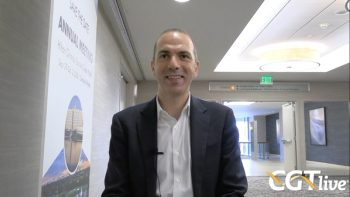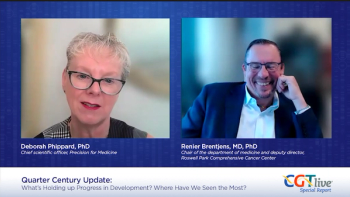The number of cell and gene therapies continues to grow. Currently, more than 1751 clinical trials in such areas as oncology, autoimmune disorders, and rare diseases are in progress.1 Autologous cell and gene therapies differ from other therapies in that they extract a patient’s cells, often genetically modify them, and then reintroduce them into the patient.2 These therapies can save patients’ lives, but patients struggle to access them.
Autologous cell and gene therapy treatments are increasingly being used to treat rare cancers and disorders such as sickle cell disease. For patients with rare disorders, obtaining the correct diagnosis and a referral to a specialist can be difficult. According to an analysis evaluating rates of diagnosis published by the National Organization for Rare Disorders (NORD), in 2019, only 36% of respondents with a rare disorder had been diagnosed within the first year. Contrastingly, the rate was 51% in 1989. Furthermore, 28% of respondents stated that receiving a diagnosis took 7 or more years. Even once diagnosed, patients may not have easy access to care. The NORD report stated that 39% of respondents needed to travel 60 or more miles for care.3 Additionally, some types of autologous therapies—such as chimeric androgen receptor (CAR) T-cell therapy treatments—are only administered at Foundation for the Accreditation of Cellular Therapy–accredited centers of excellence, and patients must stay no farther than 2 hours away from the center for at least 4 weeks.4 Patients who may have geographical access to cell therapies may encounter other barriers because these therapies, even when clinically approved for an earlier line, are often reserved for later lines of therapy due to their costs or other issues.
Insurance coverage and affordability can also affect patients’ ability to access autologous cell and gene therapy treatments, whose costs can range from $373,000 to $4,250,000.5 Moreover, despite their high one-time costs, the treatments do not guarantee certain long-term outcomes. While a therapy may be considered cost-effective at the societal level, it may not be cost-effective for a particular payer, especially in the US, where people frequently change health insurance providers.6 For instance, the Institute for Clinical and Economic Review has determined that spending as much as $6.5 million over a patient’s lifetime for a gene therapy for hemophilia can be cost-effective, due largely to replacing other treatment costs. However, paying millions of dollars for that hemophilia gene therapy is only cost-effective for a health insurance provider if the patient remains with it long enough to offset the costs it would have spent on alternative treatments over several years.7 Additionally, for autologous therapies, the direct costs are only a portion of the costs to the payers. One study examined total costs for patients who received CART therapies—either tisagenlecleucel (Kymriah; Novartis) or axicabtagene ciloleucel (Yescarta; Kite Pharma Inc), whose wholesale acquisition cost at the time of the study was $373,000—and found that the total treatment cost associated with receiving the therapy averaged more than $700,000.8
Payers are concerned about the durability of cell and gene therapy treatments in individual patients.7 Furthermore, while the Tufts Medical Center NEW Drug Development ParadIGmS initiative has found that the health care system could potentially pay for these therapies through 2030, the unequal distribution of risk among insurers, levels of government, and employers(collectively payers) remains an issue. If certain regions or populations have conditions that can be treated with cell and gene therapies at higher rates than others, certain payers could incur unsustainable expenses.7 Due to such risks, payers are likely to set strict conditions for whom they will provide coverage.
Limited payer understanding of rare disorders and associated outcomes creates further complications. The manufacturers of these advanced therapies may not always be able to perform randomized, placebo-controlled trials due to the small patient populations and lack of validated points. The lack of such trials can lead to payers restricting access to these therapies or even denying coverage.9
The affordability of autologous cell therapies for patients is another important issue. Patients incur direct out-of-pocket costs such as copays, coinsurance, deductibles, and other cost-sharing requirements. Due to the often incredibly high costs of the products, these direct costs can be considerable. Moreover, patients can incur additional indirect costs. For example, patients may have to travel to and from the specialized centers that most often administer these treatments, pay for lodging close to the center throughout their treatment and monitoring, and lose income due to them or their caregivers missing work.10 While insurance may cover some of these costs, patients may still pay out of pocket for others. One study of patients who received CART therapy for relapsed or refractory B-cell lymphoma showed that their average out-of-pocket cost was $1810. It was also found that more than half of the patients had to travel more than 50 miles for their treatment and thus likely had to bear additional travel costs.11
Key Takeaways
- Autologous cell and gene therapies offer life-saving potential but are expensive, with costs ranging from $373,000 to $4.25 million.
- Nonmonetary patient challenges include delayed diagnoses, limited geographical access to specialized centers, and high out-of-pocket costs, including travel and lodging.
- Payers express concerns over long-term efficacy, making coverage and affordability complex, and limited robust clinical trial data and patient outcomes tracking further complicate payer decisions.
Stakeholders—including patients, healthcare providers, and payers—are seeking to better understand the short-term outcomes and long-term durability of cell and gene therapies. In the short term, they want confidence that these therapies are effective. They also want to know which early signals indicate that a therapy has been effective and has not resulted in safety issues. Interestingly, payers have expressed more concern about efficacy and durability than safety even though the long-term safety risks are unknown at this point.7
Given the significant upfront investment cell and gene therapies require, stakeholders are also interested in understanding their long-term outcomes and whether they outweigh potential safety risks. Payers have stated that a minimum of 5 years of efficacy/benefit from these treatments would justify their high prices.7 However, the structure of the healthcare system impedes payers efforts to assess outcomes. Payers may not be able to track patients if they change insurers. Moreover, payers can struggle to collect information on outcomes that is not inferable from standard claims data. Negotiating an agreement between parties on what to track and who takes on the risk of a patient not having the desired outcomes is a complex process.7,12
Since cell and gene therapies are intended to be one-time, durable (potentially curative) therapies and autologous treatments require unique manufacturing processes, accessing them is more difficult than accessing other treatments. Both financial barriers and manufacturing constraints can hinder patient access. Stakeholders need to investigate potential means to simplify the manufacturing of the products necessary for autologous cell and gene therapies, innovative reimbursement models that could make them easier to afford and cover, and manufacturers’ preparations for introducing those products into the market.
REFERENCES
1. American Society of Gene & Cell Therapy. Gene, cell, & RNA therapy landscape report Q2 2024 quarterly data report. Accessed October 3, 2024. https://www.asgct.org/global/documents/asgct-citeline-q2-2024-report.aspx
2. Kazmi B, Inglefield CJ, Lewis MP. Autologous cell therapy: current treatments and future prospects. Wounds. 2009;21(9):234-242. https://pubmed.ncbi.nlm.nih.gov/25903815/
3. Barriers to rare disease diagnosis, care and treatment in the US: a 30-year comparative analysis.National Organization for Rare Disorders. November 19, 2020. Accessed October3, 2024 https://rarediseases.org/wp-content/uploads/2020/11/NRD-2088-Barriers-30-Yr-Survey-Report_FNL-2.pdf
4. Dana-Farber Cancer Institute. CAR T-cell therapy. Accessed October 1, 2024.https://www.dana-farber.org/cancer-care/treatment/cellular-therapies/car-t-cell-therapy
5. Young CM, Quinn C, Trusheim MR. Durable cell and gene therapy potential patient and financial impact: US projections of product approvals, patients treated, and product revenues. Drug Discov Today. 2022;27(1):17-30. doi:10.1016/j.drudis.2021.09.001
6. Fang H, Frean M, Sylwestrzak G, Ukert B. Trends in disenrollment and reenrollment within US commercial health insurance plans, 2006-2018. JAMA Netw Open. 2022;5(2):e220320. doi:10.1001/jamanetworkopen.2022.0320
7. Phares S, Trusheim M, Emond SK, Pearson SD. Managing the challenges of paying for gene therapy: strategies for market action and policy reform. Institute for Clinical and Economic Review. April 23, 2024. Accessed October 1, 2024. https://icer.org/wp-content/uploads/2024/04/Managing-the-Challenges-of-Paying-for-Gene-Therapy-_-ICER-NEWDIGS-White-Paper-2024_final.pdf.
8. Prime Therapeutics’ study shows total cost of care for CAR-T plus post-treatment events can exceed $1 million. News release. Prime Therapeutics LLC.April 12, 2021. Accessed September 13, 2024. https://www.prnewswire.com/news-releases/prime-therapeutics-study-shows-total-cost-of-care-for-car-t-plus-post-treatment-events-can-exceed-1-million-301266397.html
9. Hampson G, Towse A, Pearson SD, Dreitlein WB, Henshall C. Gene therapy: evidence, value and affordability in the US health care system. J Comp Eff Res. 2018;7(1):15-28. doi:10.2217/cer-2017-0068
10. Tufts Medical Center, Center for Biomedical System Design. Patient financial implications. Accessed September 13, 2024. https://newdigs.tuftsmedicalcenter.org/payingforcures/delivering-access/access-issues-for-cgts/patient-financial-implications/#gsc.tab=0
11. Di M, Potnis KC, Long JB,et al. Costs of care during chimeric antigen receptor T-cell therapy in relapsed or refractory B-cell lymphomas. JNCI Cancer Spectr. 2024;8(4):pkae059. doi:10.1093/jncics/pkae059
12. NEW Drug Development ParadIGmS Initiative at Tufts Medical Center. Access considerations for innovative treatments. Accessed October 15, 2024.https://newdigs.tuftsmedicalcenter.org/wp-content/uploads/2024/07/NEWDIGS-Implementatoion-Brief-Access-considerations.pdf.











































